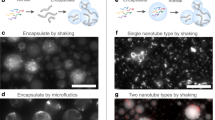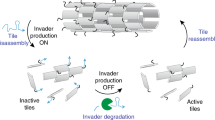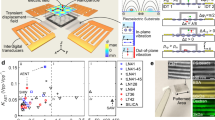Abstract
Nanotubes hold promise for a number of biological and materials applications because of their high aspect ratio and encapsulation potential. A particularly attractive goal is to access nanotubes that exert well-defined control over their cargo, such as selective encapsulation, precise positioning of the guests along the nanotube length and triggered release of this cargo in response to specific external stimuli. Here, we report the construction of DNA nanotubes with longitudinal variation and alternating larger and smaller capsules along the tube length. Size-selective encapsulation of gold nanoparticles into the large capsules of these tubes leads to ‘nanopeapod’ particle lines with positioning of the particles 65 nm apart. These nanotubes can then be opened when specific DNA strands are added to release their particle cargo spontaneously. This approach could lead to new applications of self-assembled nanotubes, such as in the precise organization of one-dimensional nanomaterials, gene-triggered selective delivery of drugs and biological sensing.
This is a preview of subscription content, access via your institution
Access options
Subscribe to this journal
Receive 12 print issues and online access
$259.00 per year
only $21.58 per issue
Buy this article
- Purchase on Springer Link
- Instant access to full article PDF
Prices may be subject to local taxes which are calculated during checkout







Similar content being viewed by others
References
Meital, R. et al. Casting metal nanowires within discrete self-assembled peptide nanotubes. Science 300, 625–627 (2003).
Hu, M. S. et al. Photosensitive gold-nanoparticle-embedded dielectric nanowires. Nature Mater. 5, 102–106 (2006).
Zhao, Y. S. et al. Low-dimensional nanomaterials based on small organic molecules: preparation and optoelectronic properties. Adv. Mater. 20, 2859–2876 (2008).
Wang, C. J. & Lin, L. Y. Nanoscale waveguiding methods. Nanoscale Res. Lett. 2, 219–229 (2007).
Banerjee, P., Perez, I., Henn-Lecordier, L., Lee, S. B. & Rubloff, G. W. Nanotubular metal–insulator–metal capacitor arrays for energy storage. Nature Nanotechnol. 4, 292–296 (2009).
Zhang, L., Rakotondradany, F., Myles, A. J., Fenniri, H. & Webster, T. J. Arginine–glycine–aspartic acid modified rosette nanotube–hydrogel composites for bone tissue engineering. Biomaterials 7, 1309–1320 (2009).
Suri, S. S., Rakotondradany, F., Myles, A., Fenniri, H. & Singh, B. The role of RGD-tagged helical rosette nanotubes in the induction of inflammation and apoptosis in human lung adenocarcinoma cells through the P38 MAPK pathway. Biomaterials 30, 3084–3090 (2009).
Hilder, T. A. & Hill, J. M. Modeling the loading and unloading of drugs into nanotubes. Small 5, 300–308 (2009).
Lu, F. et al. Advances in bioapplication of carbon nanotubes. Adv. Mater. 21, 139–152 (2009).
Yamamoto, T., Fukushima, T. & Aida, T. Self-assembled nanotubes and nanocoils from π-conjugated building blocks. Adv. Polym. Sci. 220, 1–27 (2008).
Shimizu, T. Self-assembled organic nanotubes: toward attoliter chemistry. J. Polym. Sci. A 46, 2601–2611 (2008).
Tominaga, M. & Fujita, M. Guest-induced assembly of Pdii-linked coordination nanotubes. Bull. Chem. Soc. Jpn 80, 1473–1482 (2007).
Yoog, H. et al. Polypyrrole nanotubes conjugated with human olfactory receptors: high-performance transducers for FET-type bioelectronic noses. Angew. Chem. Int. Ed. 48, 2755–2758 (2009).
Liu, G. Block copolymer nanotubes derived from self-assembly. Adv. Polym. Sci. 220, 29–64 (2008).
Zhou, Y. Lipid nanotubes: formation, templating nanostructures and drug nanocarriers. Crit. Rev. Solid State Mater. Sci. 33, 183–196 (2008).
Zhou, Y. & Shimizu, T. Lipid nanotubes: a unique template to create diverse one-dimensional nanostructures. Chem. Mater. 20, 625–633 (2008).
Shao, H. & Parquette, J. R. Controlled peptide–dendron self-assembly: interconversion of nanotubes and fibriller nanostructures. Angew. Chem. Int. Ed. 48, 2525–2528 (2009).
Gazit, E. Self-assembled peptide nanostructures: the design of molecular building blocks and their technological utilization. Chem. Soc. Rev. 36, 1263–1269 (2007).
Ngweniform, P., Li, D. & Mao, C. Self-assembly of drug-loaded liposomes on genetically engineered protein nanotubes: a potential anti-cancer drug delivery vector. Soft Matter 5, 954–956 (2009).
Liu, D., Park, S. H., Reif, J. H. & LaBean, T. H. DNA nanotubes self-assembled from triple-crossover tiles as templates for conductive nanowires. Proc. Natl Acad. Sci. USA 101, 717–722 (2004).
Yan, H., Park, S. H., Finkelstein, G., Reif, J. H. & LaBean, T. H. DNA-templated self-assembly of protein arrays and highly conductive nanowires. Science 301, 1882–1884 (2003).
Liu, C. et al. Functional DNA nanotube arrays: bottle-up meets top-down. Angew. Chem. Int. Ed. 46, 6089–6092 (2007).
Ko, S. H., Liu, H., Chen, Y. & Mao, C. DNA nanotubes as combinatorial vehicles for cellular delivery. Biomacromolecules 9, 3039–3043 (2008).
Douglas, S. M., Chou, J. J. & Shih, W. M., DNA-nanotube-induced alignment of membrane proteins for NMR structure determination. Proc. Natl Acad. Sci. USA 104, 6644–6648 (2007).
Sherman, W. B. & Seeman, N. C. Design of minimally strained nucleic acid nanotubes. Biophys. J. 90, 4546–4557 (2006).
Endo, M., Seeman, C. & Majima, T. DNA tube structures controlled by a four-way-branched DNA connector. Angew. Chem. Int. Ed. 44, 6074–6077 (2005).
Park, S. H. et al. Three-helix bundle DNA tiles self-assemble into 2D lattice or 1D templates for silver nanowires. Nano Lett. 5, 693–696 (2005).
Mathieu, F. et al. Six-helix bundles designed from DNA. Nano Lett. 5, 661–665 (2005).
Kuzuya, A., Wang, R., Sha, R. & Seeman, N. C. Six-helix and eight-helix DNA nanotubes assembled from half-tubes. Nano Lett. 7, 1757–1763 (2007).
Sobey, T. L., Renner, S. & Simmel, F. C. Assembly and melting of DNA nanotubes from single-sequence tiles. J. Phys. A 21, 1–9 (2009).
Mitchell, J. C., Harris, J. R., Malo, J., Bath, J. & Turberfield, A. J. Self-assembly of chiral DNA nanotubes. J. Am. Chem. Soc. 126, 16342–16343 (2004).
Aldaye, F. A. et al. Modular construction of DNA nanotubes of tunable geometry and single- or double-stranded character. Nature Nanotechnol. 4, 349–352 (2009).
Rothemund, P. W. K. et al. Design and characterization of programmable DNA nanotubes. J. Am. Chem. Soc. 126, 16344–16352 (2004).
O'Neill, P., Rothemund, P. W. K., Kumar, A. & Fygenson, D. K. Sturdier DNA nanotubes via ligation. Nano Lett. 6, 1379–1383 (2006).
Sharma, J. et al. Control of self-assembly of DNA tubules through integration of gold nanoparticles. Science 323, 112–114 (2009).
Jeong, G. H. et al. Cesium encapsulation in single-walled carbon nanotubes via plasma ion irradiation: application to junction formation and ab initio investigation. Phys. Rev. B 68, 0754101 (2003).
Okubo, S. et al. Diameter-dependent band gap modification of single-walled carbon nanotubes by encapsulated fullerenes. J. Phys. Chem. C 113, 571–571 (2009).
Lin, H. Y., Tsai, L. C. & Chen, C. D. Assembly of nanoparticle patterns with single-particle resolution using DNA-mediated charge trapping technique: method and applications. Adv. Funct. Mater. 17, 3182–3186 (2007).
Warner, M. G. & Hutchison, J. E. Linear assemblies of nanoparticles electrostatically organized on DNA scaffolds. Nature Mater. 2, 272–277 (2003).
Luo, J., Huang, Z., Zhao, Y., Zhang, L. & Zhu, J. Arrays of heterojunctions of Ag nanowires and amorphous carbon nanotubes. Adv. Mater. 16, 1512–1515 (2004).
Nakao, H. et al. Highly ordered assemblies of Au nanoparticles organized on DNA. Nano Lett. 3, 1391–1394 (2003).
Keren, K., Berman, R. S., Buchstab, E., Sivan, U. & Braun E. DNA-templated carbon nanotube field-effect transistor. Science 302, 1380–1382 (2003).
Braun, E., Eichen, Y., Sivan, U. & Ben-Yoseph, G. DNA-templated assembly and electrode attachment of a conducting silver wire. Nature 391, 775–778 (1998).
Aldaye, F. A. & Sleiman, H. F. Sequential self-assembly of a DNA hexagon as a template for the organization of gold nanoparticles. Angew. Chem. Int. Ed. 118, 2204–2209 (2006).
Aldaye, F. A. & Sleiman, H. F. Dynamic DNA templates for discrete gold nanoparticle assemblies: control of geometry, modularity, write/erase and structural switching. J. Am. Chem. Soc. 129, 4130–4131 (2007).
Aldaye, F. A. & Sleiman, H. F. Modular access to structurally switchable 3D discrete DNA assemblies. J. Am. Chem. Soc. 129, 13376–13377 (2007).
Aldaye, F. A., Palmer, A. L. & Sleiman, H. F. Assembling materials with DNA as the guide. Science 321, 1795–1799 (2008).
Hyperchem 7.5 (Hypercube, Gainesville, 2003).
Robert, W. The use of gold nanoparticles in diagnostics and detection. Chem. Soc. Rev. 9, 2028–2045 (2008).
Geng, Y. et al. Shape effects of filaments versus spherical particles in flow and drug delivery. Nature Nanotechnol. 2, 249–255 (2007).
Acknowledgements
The authors thank the Natural Sciences and Engineering Research Council of Canada, Canada Foundation for Innovation, Centre for Self-Assembled Chemical Structures and the Canadian Institute for Advanced Research for financial support, and K. Sears for help in running the Pt–C shadowing experiment. P.K.L and P.K. thank the Canadian Institutes of Health Research for a Chemical Biology Scholarship. H.F.S is a Cottrell Scholar of the Research Corporation.
Author information
Authors and Affiliations
Contributions
All authors discussed the results and commented on the manuscript. H.F.S. conceived and designed the project, analysed the data and co-wrote the paper. P.K.L conceived and designed the project, carried out the experiments, analysed the data and co-wrote the paper. P.K. and G.C made the confocal fluorescence and TIRF microscopy measurements and analysed the data. F.A.A. assisted in project design. C.K.M. carried out the cryo-EM experiment. G.D.H. helped with the design of nanotube 13 and with the graphical illustrations.
Corresponding author
Ethics declarations
Competing interests
The authors declare no competing financial interests.
Supplementary information
Supplementary information
Supplementary information (PDF 3299 kb)
Supplementary information
Supplementary Movie S1 (AVI 2124 kb)
Supplementary information
Supplementary Movie S2 (AVI 2124 kb)
Supplementary information
Supplementary Movie S3 (AVI 2124 kb)
Rights and permissions
About this article
Cite this article
Lo, P., Karam, P., Aldaye, F. et al. Loading and selective release of cargo in DNA nanotubes with longitudinal variation. Nature Chem 2, 319–328 (2010). https://doi.org/10.1038/nchem.575
Received:
Accepted:
Published:
Issue Date:
DOI: https://doi.org/10.1038/nchem.575
This article is cited by
-
Advances in regenerative medicine applications of tetrahedral framework nucleic acid-based nanomaterials: an expert consensus recommendation
International Journal of Oral Science (2022)
-
DNA nanostructures as templates for biomineralization
Nature Reviews Chemistry (2021)
-
DNA structures embedded with functionalized nanomaterials for biophysical applications
Journal of the Korean Physical Society (2021)
-
Crystal engineering with DNA
Nature Reviews Materials (2019)
-
Designable and dynamic single-walled stiff nanotubes assembled from sequence-defined peptoids
Nature Communications (2018)



